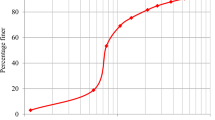Abstract
Pervious concrete is regarded as an environmentally sustainable pavement material for its storm water management and urban heat island mitigation abilities. PC has an open graded structure with interconnected voids. The interconnected pore structure helps in reducing the storm water runoff issues, water logging, and hydroplaning in urban roads. The single sized aggregates mainly used in pervious concrete are prone to abrasion loss and lower structural capacity due to increased porosity. To increase the structural capacity and reduce abrasion losses, there is a need to study pervious concrete with modified gradations. The objective of this study was to investigate pervious concrete cylinders prepared using combinations of coarse aggregates (> 4.75 mm) compacted using four different compaction types and efforts. The compaction characteristics of eight different PC mixtures were studied to identify threshold values of compaction energies, which provided porosity within acceptable limits of pervious concrete. Further, the structural capacity and abrasion losses of PC mixtures were studied for two differently graded mixtures, which provided structural and functional performance characteristics of those PC mixtures. The structural capacity of PC mixtures was determined through compressive strength test that was highly dependent on aggregate size, water-to-cement ratio, aggregate gradation, and compaction effort. The functional properties of PC mixtures were determined using abrasion resistance, mainly influenced by compaction energy and aggregate-to-cement ratio. Low compaction energy and high aggregate-to-cement ratio led to lower abrasion resistance.












Similar content being viewed by others
Abbreviations
- P4-R-2-20:
-
P4 mix, Rodding, 2 layers, 20 blows
- P4-V-10:
-
P4 mix, Vibration, 10 s
- P6-P-2-20:
-
P6 mix, Proctor hammer, 2 layers, 20 blows
- P6-M-2-20:
-
P6 mix, Marshall hammer, 2 layers, 20 blows
References
ASTM (2012) Standard test method for density and void content of hardened pervious concrete. ASTM C1754-12, American Society for Testing and Materials International, West Conshohocken, PA, USA
ASTM (2013) Standard test method for determining potential resistance to degradation of pervious concrete by impact and abrasion. ASTM C1747-13, American Society for Testing and Materials International, West Conshohocken, PA, USA
ASTM (2014) Standard test method for compressive strength of cylindrical concrete specimens. ASTM C39/C39M-14, American Society for Testing and Materials International, West Conshohocken, PA, USA
Bonicelli A, Crispino M, Giustozzi F, Shink M (2016) Laboratory analysis for investigating the impact of compaction on the properties of pervious concrete mixtures for road pavements. Adv Mater Res 723:409–419
Chandrappa AK, Biligiri KP (2016) Pervious concrete as a sustainable pavement material—research findings and future prospects: a state-of-the-art review. Constr Build Mater 111:262–274
Chandrappa AK, Biligiri KP (2016) Comprehensive investigation of special permeability characteristics of pervious concrete: a hydrodynamic approach. Constr Build Mater 123:627–637
Chen Y, Wang K, Wang X, Zhou W (2013) Strength, fracture and fatigue of pervious concrete. Constr Build Mater 42:97–104
Crouch LK, Cates MA, Dotson VJ, Honeycutt KR, Badoe D (2003) Measuring the effective air void content of Portland cement pervious pavements. Cem Concr Aggreg 25(1):16–20
Cosic K, Korat L, Ducman V, Netinger I (2015) Influence of aggregate type and size on properties of pervious concrete. Constr Build Mater 78:69–76
Deo O, Neithalath N (2011) Compressive response of pervious concretes proportioned for desired porosities. Constr Build Mater 25:4181–4189
Khankhaje E, Hussin MW, Mirza J, Rafieizonooz M, Salim MR (2016) Properties of sustainable lightweight pervious concrete containing oil palm kernel shell as coarse aggregate. Constr Build Mater 126:1054–1065
Gesoglu M, Güneyisi E, Khoshnaw G, Ipek S (2014) Abrasion And Freezing–thawing Resistance Of Pervious Concretes Containing Waste Rubbers. Constr Build Mater 73:19–24
Ghafoori N, Dutta S (1995) Building and nonpavement applications of no-fines concrete. J Mater Civ Eng 7(4):286–289
Ghafoori N, Dutta S (1995) Laboratory investigation of compacted nofines concrete for paving materials. J Struct Eng ASCE 7(3):183–191
Haselbach LM, Valavala S, Montes F (2006) Permeability predictions for sand-clogged portland cement pervious concrete pavement systems. J Environ Manag 81:42–49
Huang B, Wu H, Shu X, Burdette EG (2009) Laboratory evaluation of permeability and strength of polymer-modified pervious concrete. Constr Build Mater 24:818–823
Ibrahim A, Mahmoud E, Yamin M, Patibandla V (2014) Experimental study on portland cement pervious concrete mechanical and hydrological properties. Constr Build Mater 50:524–529
IS 2386 (PART III): Methods of test for aggregates for concrete: specific gravity, density, voids, absorption and bulking
Kevern JT, Wang K, Schaefer VR (2010) Effect of coarse aggregate on the freeze–thaw durability of pervious concrete. J Mater Civ Eng 22(5):469–475
Lian C, Zhuge Y (2010) Optimum mix design of enhanced permeable concrete—an experimental investigation. J Constr Build Mater 24:2664–2671
Neithalath N, Sumanasooriya MS, Deo O (2010) Characterizing pore volume, sizes, and connectivity in pervious concretes for permeability prediction. Mater Charact 6(1):802–813
Putman BJ, Neptune AI (2011) Comparison of test specimen preparation techniques for pervious concrete pavements. Constr Build Mater 25:3480–3485
Sahdeo SK, Ransinchung GD, Rahul KL, Debbarma S (2020) Effect of mix proportion on the structural and functional properties of pervious concrete paving mixtures. Constr Build Mater 255:119260
Sahdeo SK, Ransinchung G, Rahul KL, Debbarma S (2021) Reclaimed asphalt pavement as a substitution to natural coarse aggregate for the production of sustainable pervious concrete pavement mixes. J Mater Civ Eng 33(2):04020469
Tennis P, Leming M, Akers D (2004) Pervious concrete pavements. Portland Cement Association, Skokie
Torres A, Hu J, Ramos A (2015) The effect of the cementitious paste thickness on the performance of pervious concrete. Constr Build Mater 95:850–859
Yang J, Jiang G (2003) Experimental study on properties of pervious concrete pavement materials. Cem Concr Res 33:381–386
Yahia A, Kabagire KD (2014) New approach to proportion pervious concrete. Constr Build Mater 62:38–46
Author information
Authors and Affiliations
Corresponding author
Additional information
Publisher's Note
Springer Nature remains neutral with regard to jurisdictional claims in published maps and institutional affiliations.
Rights and permissions
About this article
Cite this article
Sahdeo, S.K., Chandrappa, A. & Biligiri, K.P. Effect of Compaction Type and Compaction Efforts on Structural and Functional Properties of Pervious Concrete. Transp. in Dev. Econ. 7, 19 (2021). https://doi.org/10.1007/s40890-021-00129-0
Received:
Accepted:
Published:
DOI: https://doi.org/10.1007/s40890-021-00129-0




